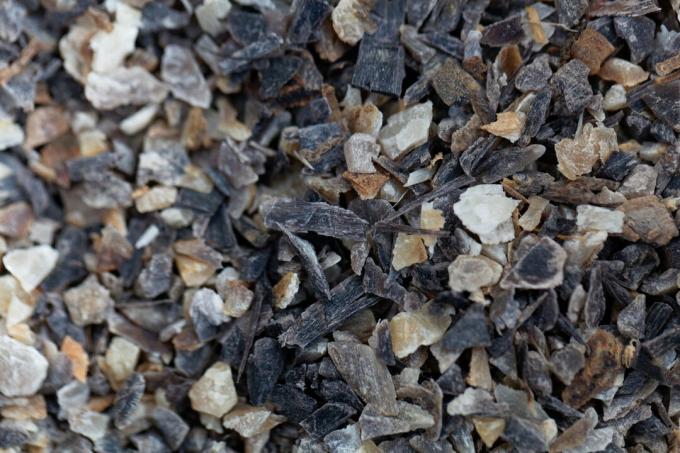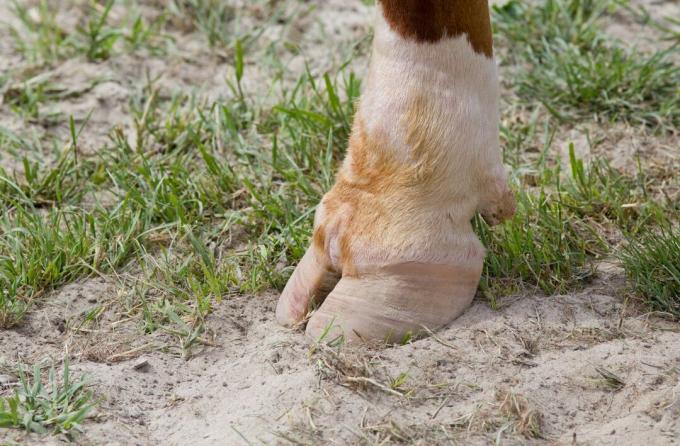Here you can find out how to properly use horn shavings as fertilizer, what the advantages and disadvantages are and whether horn shavings are poisonous.

Horn shavings are among the organic fertilizers and have a high nitrogen content. Nitrogen is essential for plants. But it should already be revealed at this point that just a high nitrogen content does not make the best fertilizer for your own plants. What you should know about horn shavings in order to decide whether you want to use them as fertilizer in the garden is what we will tell you below.
contents
- Composition of horn shavings
- Mode of action of horn shavings
- Disadvantages of horn shavings
- Fertilize the garden with horn shavings: when and how much?
- Are horn shavings poisonous?
- Buy horn shavings
Horn shavings consist of the crushed horn and hooves of animals for slaughter. Therefore, they belong to the secondary raw material fertilizers, which means that they are produced from animal waste products. Other secondary raw material fertilizers are for example
compost or wood ash.Composition of horn shavings
Fertilizers from horn and hooves consist of 80% organic matter. The nitrogen content in the horn shavings is inherently very high, but potassium and phosphorus are only contained in small amounts (> 1%). Therefore, other substances are added to the horn fertilizers, so that the different fertilizers differ somewhat in the composition of the remaining mineral ingredients:
- Horn meal contains 10-13% nitrogen, 5% phosphorus and 7% calcium
- Horn semolina contains 12-14% nitrogen, 6-8% phosphorus and 7% calcium
- Horn shavings contain 9-14% nitrogen, 6-8% phosphorus and 7% calcium

The difference between the different horn fertilizers is the degree of grinding. This is as follows for the different varieties:
- horn meal < 1 mm
- Horn meal or semolina 1 – 5 mm
- Horn shavings > 5 mm
Mode of action of horn shavings
This solid organic fertilizers has a long-term effect. It takes up to three months for the nitrogen and other nutrients to be released and become available to the plant roots in the soil solution. The soil microbes break down the horn shavings relatively slowly, but the fertilizer effect is more lasting than with mineral fertilizers out of business. With horn meal, however, the release of nitrogen occurs somewhat faster because it is ground more finely. This releases the nitrogen after just a few weeks. The pH of these fertilizers is neutral, i.e. around 7. Over-fertilization is practically impossible with this nitrogen fertilizer because it works very slowly. In addition, the nutrients only get into the soil solution in very small doses over a longer period of time.
Disadvantages of horn shavings
Horn shavings are probably not the right choice of fertilizer for many hobby gardeners. They are out of the question, especially for animal lovers. One problem with horn shavings is that unfortunately one cannot trace the origin of the animals from which the horn shavings are obtained. It is therefore not clear whether the animals are domestic animals for slaughter or animals from overseas. Unfortunately, even the addition "BIO" does not guarantee that animals come from organic farming.

It should also be viewed critically that in factory farming the animals are often given large amounts of antibiotics. The resulting resistance poses a major problem.
Fertilize the garden with horn shavings: when and how much?
If you still decide to use horn shavings in the garden, this should be done between March and October. You can spread the horn shavings in autumn and work them into the soil - this way your plants will receive the released nutrients in spring. Horn shavings can also be placed directly in the planting hole when planting. The advantage here is that horn shavings are easy to use.
Spread the horn shavings evenly over the surface or around the plants by hand and carefully work them into the top layer of soil. Also, water the surface thoroughly so that the nutrients are dissolved more quickly and the odor is reduced. Horn shavings don't exactly smell good. When sowing, simply scatter the horn shavings when digging or when preparing the seedbed and bring them evenly into the soil.
Recommended application rates for horn shavings in different crops:
| Culture | Amount before sowing per m² | Amount after one week after emergence per m² |
|---|---|---|
| Tomatoes, Celery, Cauliflower, Broccoli, Brussels Sprouts, Beets | 60g | 80g |
| carrots | 30g | 80g |
| Cucumbers, spinach, leeks, zucchini, kale | 60g | 50g |
| radish, peppers | 50g | 40g |
| endive, beans, potatoes, onions | 40g | 30g |
| Peas, radishes, asparagus | 40g | - |
For balcony plants and potted plants, mix about 10 g of horn shavings per liter of soil, which corresponds to a heaped tablespoon. With normal plantings in the garden, around 60 to 120 g of horn shavings can be distributed per square meter. This corresponds to a quantity of one to two hands. You can also apply horn shavings to your compost and thus improve its quality and rotting.

In the lawn fertilization you can also use horn meal and horn shavings if desired. About 30 g per square meter are sufficient. If the lawn turns yellow, you can try to combat the lack of nitrogen with horn meal. However, we recommend that you rely on primarily organic and animal-free fertilizers with a long-term effect, such as our Plantura Organic Lawn Fertilizer or ours Organic autumn lawn fertilizer. These have the additional advantage of being very odorless and easy to apply.
Are horn shavings poisonous?
Horn shavings do not contain any substances that are hazardous to health. Even if stored correctly, no toxic effects are generally to be expected. Nevertheless, one should of course not put horn shavings on the menu. Sensitive people can already react sensitively when they come into contact with the product dust. Therefore, you should wash both your hands and face after use. For pets, the smell of horn shavings can have a stimulating effect and the four-legged friends could start digging up your garden. You should therefore water your areas properly after application to reduce the risk of your garden becoming an unintentional victim of your four-legged friends.
Buy horn shavings
Since the majority of cows in our latitudes are dehorned, the chips can only be obtained from the hooves. It can therefore sometimes happen that the horn shavings and horn meal come from overseas. Unfortunately, the addition "BIO" on horn shavings does not guarantee the origin of animals that are kept in a biologically fair manner. Horn shavings can be purchased in different quantities - sacks are available from one kilogram to 25 kg and up to 50 kg.
If you want to learn more about sustainable fertilizers, you can find ours here Plantura organic fertilizer.
